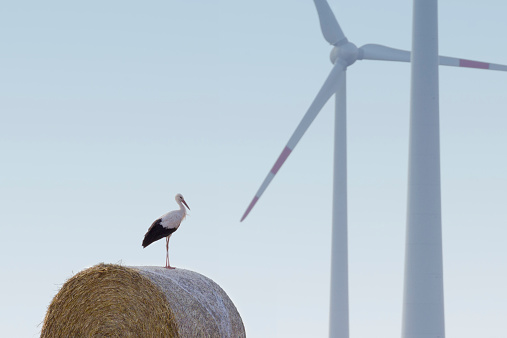 Wind energy has rapidly migrated from a small to significant source of energy generation, resulting in increased attention to and regulation of wind energy's impact on birds and bats. Given the recent activity in environmental law, now is a good time to review all of the recent developments pertaining to wind power and wildlife protection.
Wind energy has rapidly migrated from a small to significant source of energy generation, resulting in increased attention to and regulation of wind energy's impact on birds and bats. Given the recent activity in environmental law, now is a good time to review all of the recent developments pertaining to wind power and wildlife protection.
Enforcement
- To date, the federal government has entered into only two plea agreements (with PacificCorp in December 2014 and Duke Energy in November 2013) with respect to alleged Bald and Golden Eagle Protection Act (BGEPA) and Migratory Bird Treaty Act (MBTA) violations.
- The U.S. Fish and Wildlife Service (FWS) is currently investigating takes by at least 15 wind facilities, several of which have been referred to the Department of Justice for possible prosecution.
- One developer has voluntarily entered into a settlement agreement with the FWS to preempt enforcement of takes at several projects.
Litigation
- On Sept. 9, a 5th circuit appeals court overturned a conviction against a petroleum company for the incidental take of migratory birds, thereby deepening the circuit split over how to define "take" under the MBTA.
- In January, a suit was filed by the Garden Peninsula Foundation claiming that the FWS failed to require a National Environmental Policy Act (NEPA) review and take permits under the Endangered Species Act (ESA) and the BGEPA for a Michigan wind project. The FWS filed a motion to dismiss, asserting that projects on private land fall outside of its regulatory authority. The outcome of this case could have a material impact on future wind development on private land.
Incidental Take Permits (ITPs)
- In January, a bill was introduced into the House to exempt criminal liability for incidental take under the MBTA, require 30-year take permits under the BGEPA and set a one-year deadline for the FWS to issue decisions on BGEPA take permit applications.
- In March, the Merricourt Wind Farm in North Dakota applied for an ESA ITP for piping plovers and one whooping crane. If approved, it will be the first ITP ever issued to a wind project for take of a whooping crane.
- In May, the FWS issued a notice of intent to consider authorizing ITPs under the MBTA. Given the lengthy regulatory review process, MBTA permits will not be available in the short term, and in the meantime, taking migratory birds remains a criminal offense.
- On Aug. 11, a California district court overturned an FWS rule authorizing 30-year BGEPA take permits for failure to comply with NEPA. The FWS already commenced a NEPA review and aims to finalize revised regulations by 2017. This decision does not prohibit further issuance of five-year BGEPA take permits. Only one five-year permit, and no 30-year permits, has been issued to date, although several applications are pending.
Multi-State Habitat Conservation Plans
- The FWS is preparing multi-state and multi-species habitat conservation plans (HCPs) to address certain incidental takes by wind projects. HCPs currently undergoing NEPA reviews include the following:
- The Midwest Wind Multi-Species HCP, covering the take of four bat species, bald eagle, interior least tern, Kirkland's warbler and piping plover across eight Midwestern states; and
- The Great Plains Wind Energy HCP, covering take of the whooping crane, interior least tern, piping plover and Lesser Prairie Chicken across the Great Plains.
ESA Listings
- In April, the FWS listed the Northern Long Eared Bat (NLEB) as threatened under ESA due to white-nose syndrome (WNS) and issued an interim 4(d) rule exempting certain activities outside the WNS buffer zone, including wind energy, from incidental take.
- Takes by wind projects within the WNS buffer zone are not exempt. The Center of Biological Diversity filed a lawsuit asking the D.C. Circuit Court to invalidate the rule pending a full NEPA review. In response, a bill to prevent listing NLEB as endangered for another year has been introduced in the House.
- Pursuant to a 2011 settlement, the FWS must make a final determination on whether to list the sage grouse as threatened or endangered by Sept. 30. If listed, wind projects with potential to impact the sage grouse may need to conduct additional studies, implement mitigation measures or apply for ITPs. Additionally, on May 29, the U.S. Bureau of Land Management released final environmental impact statements to amend existing resource management plans in 10 western states, which would prevent wind development in and near sage grouse habitats.
- On Sept. 1, a Texas district court vacated the FWS' listing of the Lesser Prairie Chicken as threatened under the ESA finding that the FWS' decision was arbitrary and capricious. This is the first time a court has vacated an ESA listing on the grounds that the FWS did not properly consider conservation efforts. The FWS has 60 days to appeal.
Given the rapid pace of wind development, regulation of potential wildlife impact from wind development has become increasingly complex. It is important for wind developers to consult with legal counsel in the earliest stages of a project and throughout the life of the project in order to remain up to date on the latest developments.
Matthew H. Ahrens is a partner and Meghan Gabriel is an associate at Milbank, Tweed, Hadley & McCloy. They can be reached at mahrens@milbank.com and mgabriel@milbank.com.



